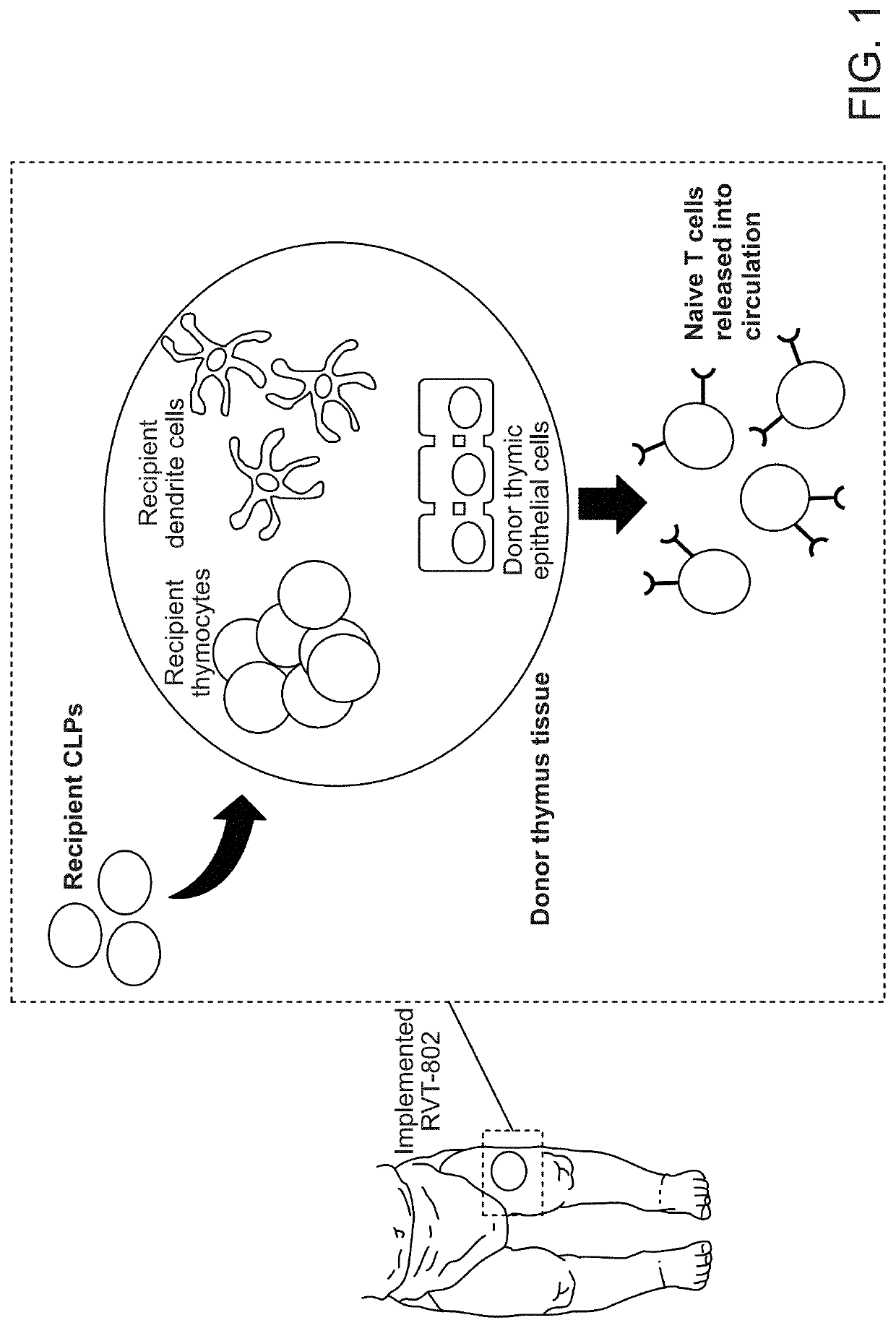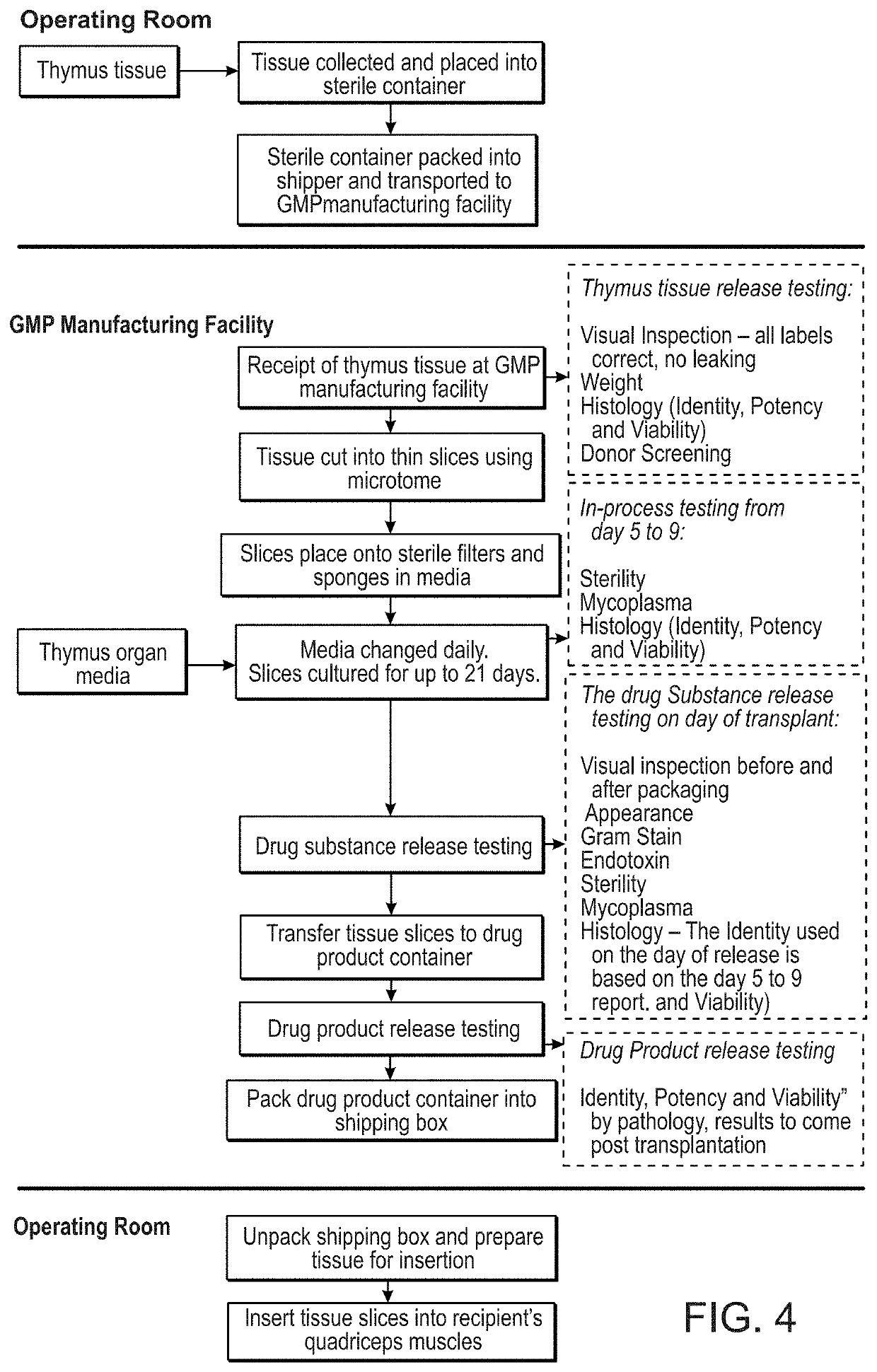Methods of determining the suitability of cultured thymus tissue for implantation into humans and associated methods of use
a technology of thymus and cultured thymus, which is applied in the field of determining the suitability of cultured thymus for human implantation and associated methods of use, can solve the problems of difficult translation to the clinic without xenotransplantation, non-vascularized thymus not inducing tolerance, and inability to achieve consistent transplant tolerance, etc., to prevent autoimmune diseases, prevent autoimmune diseases, and prevent infection. the effect of rapid detection
- Summary
- Abstract
- Description
- Claims
- Application Information
AI Technical Summary
Benefits of technology
Problems solved by technology
Method used
Image
Examples
example 1
mus Variability Study
[0897]Intra-thymus variability was studied to determine whether histology testing results from one part of a thymus could be considered representative of histology testing results in any other part of the same thymus. The results of this test were used to determine how many samples should be tested during both routine release testing and for process validation testing.
[0898]Histology acceptance criteria were established, as noted previously, including the assessment of: areas positive for keratin AE1 / AE3 scattered throughout tissue on days 5-9; at least 1 Hassall body identified; CK14 staining scattered throughout tissue; and intact nuclei observed.
[0899]For this study, three thymuses were sliced in a directional manner and the location of the slices within each thymus was tracked. Slices were cultured in 6-well plates to allow tracking of each slice. Slicing was conducted as shown in FIG. 5A.
[0900]For each thymus in the study, slices were dedicated for analysis...
example 2
mus Time-Course Study
[0906]For this study, five thymuses were sliced and cultured per SOP. On the day of slicing, the first, middle and last slices were prepared for immunohistochemistry. The remainder of each thymus was sliced and cultured in 6-well plates. Each thymus was designated for one of the following time points: baseline (day 0), day 5, day 9, day 12 and day 21. See FIG. 7 for a day 0 thymus slice, FIG. 8 for a day 5 slice, FIG. 9 for a day 12 slice, and FIG. 10 for a day 21 slice.
[0907]The total number of slices from each thymus ranged from 21 to 62 slices. Slices were cultured per the procedures outlined above with daily media changes. Slices were submitted for H&E staining in the pathology lab and analyzed for identity, potency and viability. All slices in this study met the release acceptance criteria for histology testing, namely: areas positive for keratin AE1 / AE3 scattered throughout tissue on days 5-9; at least 1 Hassall body identified; CK14 staining scattered thr...
example 3
ssue Forced Degradation Study
[0913]In this study, thymus tissue slices were treated to generate tissue slices that were considered degraded or non-viable. Three thymuses were used for these experiments. Control samples were taken from each thymus. The treatment conditions presented in Table 7 were tested.
TABLE 7Forced Degradation Treatment ConditionsDuration of ConditionTreatmentControlNo treatmentHeat Shock, 55° C. 4 hoursFreeze / thaw, −20° C. / ambient 4 hoursRoom Temperature, 20-24° C. (Culture in BSC)24 hoursDehydration (Culture in absence of media)24 hours48 hoursNutritional Depletion, (Culture in Normal Saline)24 hours48 hoursOsmolarity Change, (Culture in 10X PBS)24 hoursDMSO Exposure, (Culture in 1% DMSO in TOM)24 hours
[0914]Heat shock was accomplished by placing the 10 cm culture dish containing the slices into a Ziploc bag, and placing into a 55° C. water bath. The plate rested on a support and was not submerged. Freeze / thaw was accomplished by placing the 10 cm culture dish ...
PUM
 Login to View More
Login to View More Abstract
Description
Claims
Application Information
 Login to View More
Login to View More - R&D
- Intellectual Property
- Life Sciences
- Materials
- Tech Scout
- Unparalleled Data Quality
- Higher Quality Content
- 60% Fewer Hallucinations
Browse by: Latest US Patents, China's latest patents, Technical Efficacy Thesaurus, Application Domain, Technology Topic, Popular Technical Reports.
© 2025 PatSnap. All rights reserved.Legal|Privacy policy|Modern Slavery Act Transparency Statement|Sitemap|About US| Contact US: help@patsnap.com



